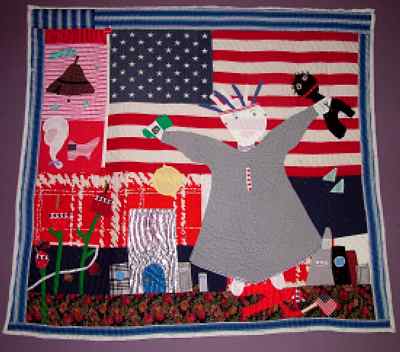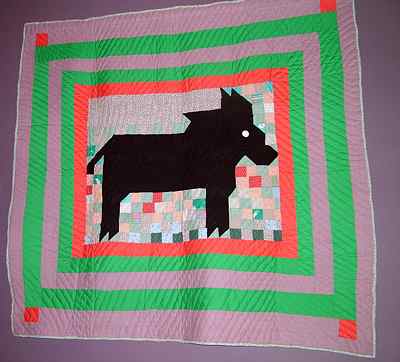
Editor's note: The Pasadena Museum of History, History Center Galleries provided source material to Resource Library for the following article or essay. If you have questions or comments regarding the source material, please contact The Pasadena Museum of History directly through either this phone number or web address:
African American Quilts from the Robert and Helen Cargo Collection
May 12 - August 5, 2007
African American Quilts from the Robert and Helen Cargo Collection, a traveling exhibition developed by the International Quilt Study Center at the University of Nebraska-Lincoln, will be on display in the History Center Galleries at the Pasadena Museum of History from May 12 through August 5, 2007.
The exhibit features 30 quilts from the southeastern USA by quilters Dennis Jones, Mary Maxtion, Lureca Outland, Martha Jane Pettway, Sarah Mary Taylor, Yvonne Wells and Lucile Young, dating from the 1930s to the 1990s. These extraordinary works of textile art reflect broad scope of African-American quilting and celebrate the diverse traditions of our American quilting and cultural heritage.
The privately held Robert and Helen Cargo Quilt Collection is widely recognized as one of the most significant quilt collections in the United States. It includes over 1,500 quilts and 400 quilt tops. The collection concentrates primarily on quilts from Alabama.
Special docent-guided tours of the galleries and public programs that complement the exhibition's themes are scheduled during the exhibit's 12-week run. Please check the Programs & Events listings at /www.pasadenahistory.org/ for continuously updated information.

(above: Yvonne Wells, "Being in Total Control of Herself," 1990; inspired by the quilter's first trip to New York City)

(above: Lureca Outland, "Mule", one of two quilts in the exhibit by Outland using the same mule motif. The quilter recently celebrated her 104th birthday.)
Introductory Text at Gallery Entrance
African-American quilts are an important segment of American quilt history. They reflect the diverse traditions that merge to form our American quilting heritage. African-American quilts come in every imaginable style: traditional patterns and made-up patterns, bold colors and subdued colors, pieced quilts and story quilts, small stitches and large stitches. Like all American quilts, African-American quilts vary from region to region, from era to era, and from person to person.
The quilts from the Robert and Helen Cargo Collection are products of one region: the South, mainly Alabama. Through years of interacting with African-American quilters in the Tuscaloosa area, Dr. Cargo collected well over 300 fine examples of regional quiltmaking. While most of the quilts were made since the 1970s by women with whom Dr. Cargo was acquainted, some of the anonymous quilts in the collection date as far back as the early twentieth century. In May 2000, 156 quilts from the Robert and Helen Cargo Collection became part of the International Quilt Study Center at the University of Nebraska-Lincoln. This exceptional body of quilts adds a new facet of American quilt history to the Center's world-class collection.
The quilts in this exhibition offer a glimpse into the creative process of a group of African-American quiltmakers. Note the similarities between quilts: similar patterns, similar color usage, and similarities to traditional American quilt patterns. But, most importantly, note the uniqueness of each piece, that quality that makes each quilt a one-of-a-kind piece of art.
Curator's Statement
The Robert and Helen Cargo Collection at the University of Nebraska
In May 2000, 156 African-American quilts from the Robert and Helen Cargo Collection became part of the International Quilt Study Center at the University of Nebraska-Lincoln. This exceptional body of quilts adds a new facet of American quilt history to the Center's world-class collection. The quilts from the Robert and Helen Cargo Collection are products of the South, mainly Alabama. Through years of interacting with African-American quilters in the Tuscaloosa and northern Alabama area, Dr. Cargo collected more than three hundred examples of regional quiltmaking. Most of the quilts were made since the 1970s by women with whom Dr. Cargo was acquainted, though some of the anonymous quilts in the collection date as far back as the early twentieth century.
The Cargo Collection was acquired by the International Quilt Study Center at the University of Nebraska through the generosity of Robert and Helen Cargo and the Robert and Ardis James Foundation.
Quilting & Exhibit Facts
Quilts made by rural Black women in Alabama, Georgia, and Mississippi share certain features such as: bold strips, bright colors, large designs, asymmetry, multiple patterns, symbolic forms and improvisation.
Biography of Yvonne Wells
A teacher in the public school system of Tuscaloosa, Alabama, Mrs. Wells is completely self-taught as a quiltmaker and an artist. From her first efforts at quiltmaking in 1979, she moved rapidly in the direction of picture quilts. Without patterns or templates, armed only with fabrics and a pair of scissors, Mrs. Wells cuts freehand the material required to construct the images. Whereas some artists require paint, Mrs. Wells uses fabrics.
In the early picture quilts, stories were told using little stick figures of approximately 8-10 inches tall. Gradually as her confidence grew, the figures became larger so that today a single figure may occupy the entire quilt. Indeed, in a series of three self portraits entitled "Me Masked", the face occupies the entire surface of the work.
The first serious exposure for the work came in 1989 when she was included in an exhibition of African-American story quilts, curated by Eva Grudin at Williams College in Williamstown, Ma. Since that time, Mrs. Wells' work has been exhibited in Japan and other countries of Asia and was included in a major exhibition of Alabama art in the summer of 2000 in the South of France.
The two most common subjects Mrs. Wells treats in her quilts are those based on Biblical texts and social/political themes, many of which focus on the civil rights struggle of her people in the South.
In a recent and brief assessment of Mrs. Wells' work by Cynthia Elyce Rubin, Dr. Rubin writes: "With no formal training, only absolute determination, she embarked on a personal journey of discovery. Within about four years, her unique style took shape. Reflecting her animated and lively personality, intense hues combine with unusual color combinations to enliven a rich design vocabulary." (Cynthia Elyce Rubin, "Handmade Quilts by a Born Storyteller," (FIBERARTS, Sept.-Oct., 2000, p. 15).
Mrs. Wells is a folk artist who has an international reputation. Her quilts are located in major quilt and folk art collections across the country and the collection of the Birmingham Museum of Art. She was given a solo exhibition by the Huntsville Museum of Art and in 1998 she received the prestigious Alabama Arts Award and Visual Arts Craftsmen Award.
She has been invited to present and discuss her quilts at the Museum of American Folk Art (New York) and has twice been invited to show and discuss her work at the Hallmark Card Company. Three of her quilts have been issued as greeting cards by that company. A group of 24 of her early creations was recently selected to become a part of the International Quilt Study Center at the University of Nebraska in Lincoln. Mrs. Wells was invited to speak at the first exhibition of the Center's African-American quilt collection in February, 2001
Article by Robert Cargo
For a companion article concerning the exhibition please see African American Quilts of Alabama: Flowers without Roots?
Quilt Characteristics
Both historic and contemporary African-American quilters, like any other quilters, have a choice of styles and techniques, some individually inspired and some based on previous models. However, quilt scholars have identified two styles with distinct characteristics: the Afro-traditional and the Standard-traditional. Some quilters work exclusively in one style, some in both, and some may mix the two together in a quilt.
Afro-traditional quilts illustrate characteristics typical of the construction techniques and patterns found in historic and contemporary African textiles.
Characteristics are:
Standard-traditional quilts utilize construction techniques and patterns found in historic and contemporary European/American traditional quilts.
Characteristics are:
Public Programs
The following public programs are being presented by the Pasadena Museum of History in conjunction with the exhibition African American Quilts from the Robert and Helen Cargo Collection. There are fees for all events except the Patchwork Picnic.
About the International Quilt Study Center at the University of Nebraska-Lincoln
The International Quilt Study Center at the University of Nebraska-Lincoln connects the world to quilts. The IQSC is devoted to the preservation, study and exhibition of quilts and most importantly, to sharing our resources with the public. The center promotes the discovery of quilts and quiltmaking traditions from many cultures, countries, and time periods.
Established in 1997 at the University of Nebraska-Lincoln, the center now holds nearly 2300 quilts, the largest publicly held collection in the world. These quilts are an extraordinary historical and artistic resource representing nearly twenty countries, and dating from as far back as the early 1700s to the present.
To date the center has organized over 20 comprehensive quilt exhibitions which have traveled to more than 50 locations throughout the United States and internationally. Thousands of people have viewed first hand the quilting artistry of individuals from the eighteenth century up to the current day.
More quilts, more exhibitions, and more visitors led to a plan for a new home for the International Quilt Study Center. Made possible by private donations, the new museum of the International Quilt Study Center will be open to the public in early 2008. The environmentally sustainable "green" building is under construction at 33rd and Holdrege Streets near the East Campus of the University of Nebraska-Lincoln.
The IQSC's academic home is within the Department of Textiles, Clothing and Design in the College of Education and Human Sciences. Students participate on-site and via distance learning in the one-of-a-kind graduate program offered in Textiles History with a Quilt Studies emphasis.
For more information visit www.quiltstudy.org
About the Pasadena Museum of History
Founded in 1924 to preserve and share the rich history, art, and culture of Pasadena and neighboring communities, the Pasadena Museum of History has developed into one of the country's premiere institutions of its size. The museum is located at 470 W. Walnut St. (corner Orange Grove Blvd. & Walnut St.), Pasadena, CA 91103. Please see the Museum's website for details on hours and admissions.
Editor's note: RL readers may also enjoy:
Links to sources of information outside of our web site are provided only as referrals for your further consideration. Please use due diligence in judging the quality of information contained in these and all other web sites. Information from linked sources may be inaccurate or out of date. TFAO neither recommends or endorses these referenced organizations. Although TFAO includes links to other web sites, it takes no responsibility for the content or information contained on those other sites, nor exerts any editorial or other control over them. For more information on evaluating web pages see TFAO's General Resources section in Online Resources for Collectors and Students of Art History. Individual pages in this catalogue will be amended as TFAO adds content, corrects errors and reorganizes sections for improved readability. Refreshing or reloading pages enables readers to view the latest updates.
Visit the Table of Contents for Resource Library for thousands of articles and essays on American art.
Copyright 2007 Traditional Fine Arts Organization, Inc., an Arizona nonprofit corporation. All rights reserved.